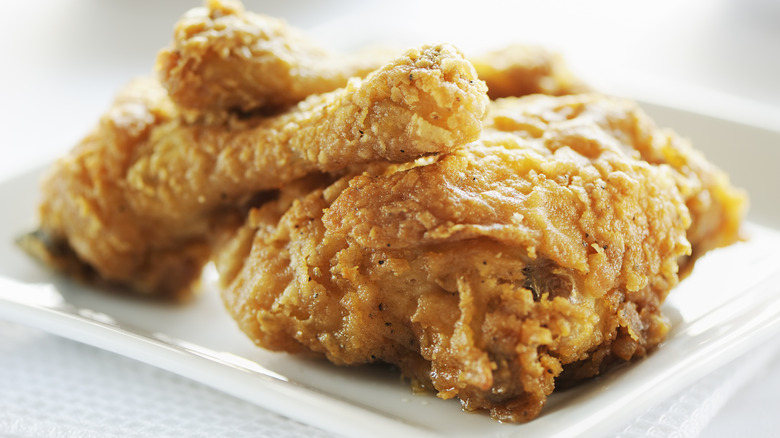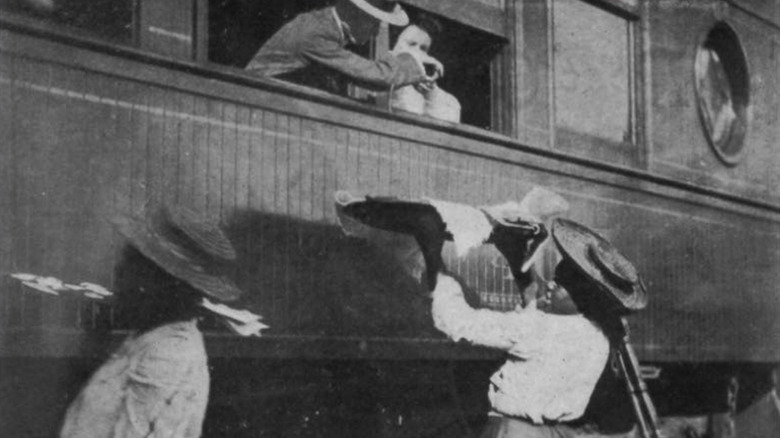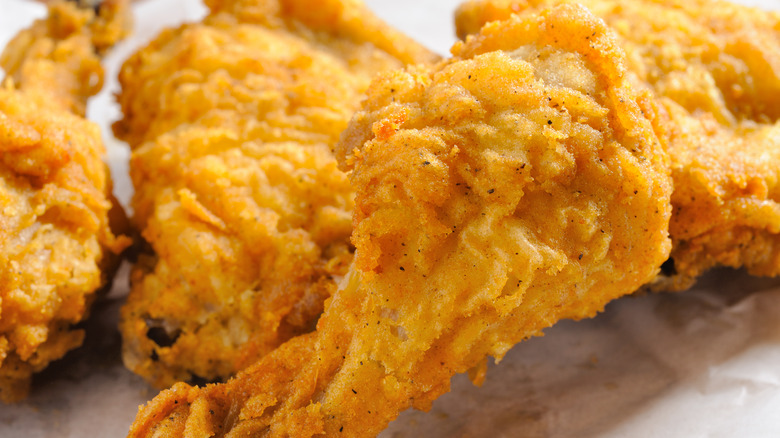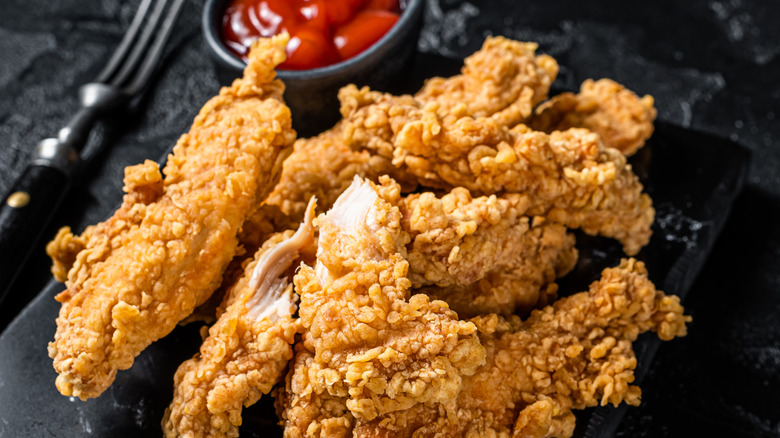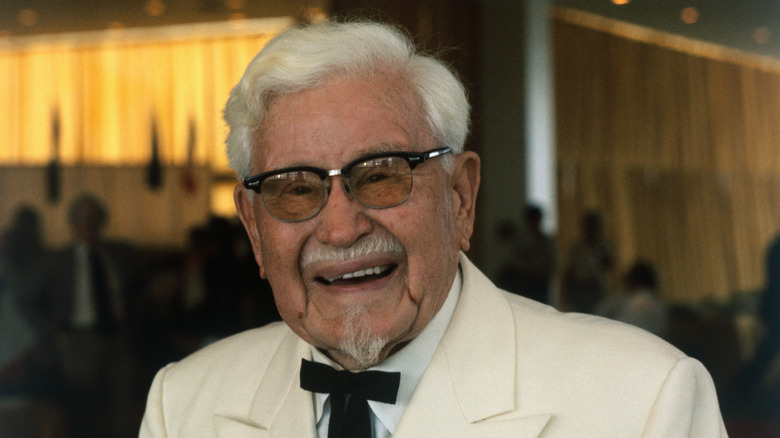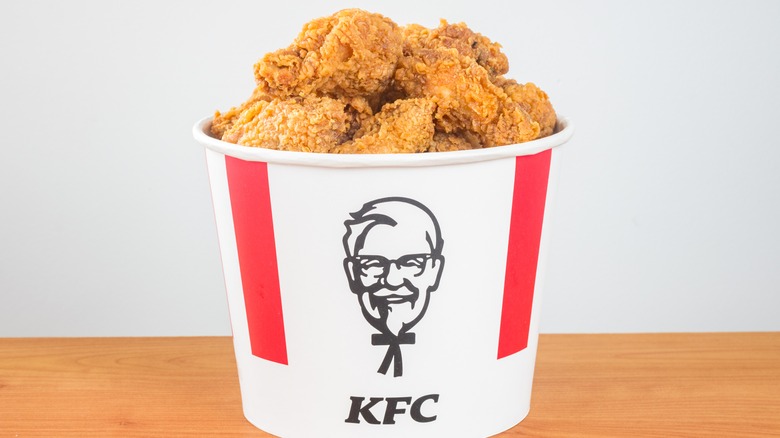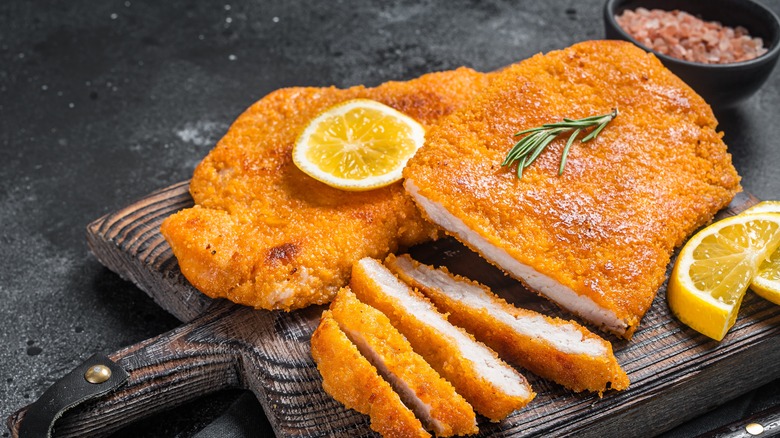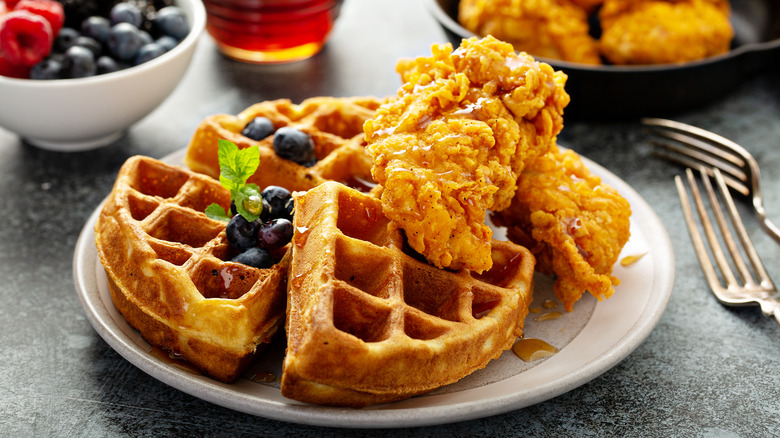The Strange Untold History Of Fast Food Fried Chicken
When a top Portland marketing agency asked 1,000 Americans about their attitude toward fried chicken, 50% responded that they loved it and 16% said that they would marry the crispy snack, as reported by National Today. As such, it's little surprise that 49% of Americans indulge in the fried dish at least once per week (via ChefSteps). Moreover, the country celebrates National Fried Chicken Day annually on July 6. The month of July also brims with other poultry-related celebrations, including National Chicken Finger Day on July 27 and National Chicken Wing Day on July 29.
Commonly associated with comfort food, fried chicken is beloved across the globe. From fast food joints in the U.S. to street stalls in Asia, there are many variations on the dish, each with its own unique seasoning and preparation techniques. Regardless of the style, fried chicken's universal appeal lies in its satisfying combination of crunchy coating and juicy meat. Often hailed as the quintessential American fast food, fried chicken comes with a fascinating history that's probably much longer and more complicated than you realize. Eager to discover more? Keep reading!
Fried chicken has roots in ancient Rome
The fact that fried chicken predates the first fast food joints by thousands of years may come as a surprise to many. In fact, the delicious dish was invented during the Roman Empire, lasting between 27 B.C. and A.D. 476, as asserted in a cookbook entitled "De Re Coquinaria." Translating to "The Art of Cooking," the culinary manual detailed recipes from the ancient Roman chef Marcus Gavius Apicius, who lived in the 1st century AD.
Apicius' Pullum Frontonianum (Chicken à la Fronto) recipe calls for one chicken, 100 milliliters of oil, 200 milliliters of liquamen (fish sauce), 200 milliliters of wine, one leek branch, dill, coriander, pepper, salt, saturei (a type of spice), and a little defritum (a Roman take on grape syrup). The chicken was fried in oil and liquamen, and seasoned with saturei, dill, coriander, and leek. It was then transferred to an equivalent of today's oven, and cooked for another hour. Once ready, the chicken would be served over defritum, and sprinkled with salt and pepper.
The recipe for fried chicken was brought to the U.S. by Scottish immigrants
Although fried chicken is commonly associated with Southern cuisine, numerous historians assert that the recipe for the poultry dish arrived in the U.S. with Scottish immigrants during the 18th century. While most European countries at the time had a tradition of baking or boiling chicken, the Scots had been deep frying poultry in fat since the Middle Ages. A notable account that traces the roots of the dish is a 1773 diary entry by biographer James Boswell about a fried chicken dinner he had eaten at Coire-chat-achan on the Isle of Skye, as reported by the BBC.
While it may have been Scottish immigrants who introduced the U.S. to fried chicken, they are definitely not the ones who popularized it. The credit for that goes to enslaved African Americans who incorporated the dish into their own food culture, and gave it the unique twist we know and love today. While Scots would eat their fried chicken without any seasoning, African American women infused the poultry with spices, and used their own preparation methods to make the dish. It's this version of fried chicken that eventually became so popular in Southern cuisine.
The recipe for fried chicken was perfected by African American women
After slavery was abolished in 1865, African American women started using their culinary expertise to provide for themselves and their families. Perhaps the best example of this entrepreneurial spirit took place in Gordonsville, Virginia, where Black women were the driving force behind a very special industry based around fried chicken.
Despite its population of just 900 at the time, Gordonsville was a key stop for two railroad lines. Given that trains of that era lacked dining cars, passengers had to rely on other solutions to fill their stomachs. While some may have brought their own food, others were more than happy to buy their meals along the journey.
Seeing a gap in the market, African American women started supplying passing travelers with their fried chicken, pies, and biscuits. Commonly called "waiter carriers," the women would stand on the platform and hand over their goods to passengers through the train windows. By the turn of the century, the majority of trains had been equipped with dining cars, and governmental regulations had grown more stringent on platform food vendors. This crackdown ultimately led to the end of the unique entrepreneurial tradition.
Gordonsville, Virginia, has been named the fried chicken capital of the world
Ever since Gordonsville, Virginia became a bustling commuter center in the latter part of the 19th century, fried chicken has played a key role in its history and development. Today, the town holds the accolade of being the fried chicken capital of the world in honor of the meaty dish, and the entrepreneurial African American women who played such a vital role in its creation and popularization.
Gordonsville was first given the title of the fried chicken capital of the world by writer George W. Bagby in 1869, a time when recently liberated Black women would feed the hungry hordes that passed through the town from railway platforms. While the introduction of dining cars gradually pushed African American women out of business, Gordonsville still remembers their legacy with a plaque that reads, "With the introduction of rail service, enterprising African American women commenced a tradition that was to symbolize Gordonsville forever as the 'Fried Chicken Capital of the World'" (via Eater).
The first American fried chicken recipe appeared in a cookbook in 1824
The first written account of fried chicken in the U.S. comes from Virginia Governor William Byrd who used to indulge in the dish in the early 18th century. While Byrd's observations took the form of a diary entry, it wasn't until 1824 that a fried chicken recipe made an appearance in an American cookbook. Published in "The Virginia Housewife," the recipe advises chefs to cut the chicken "as for the fricassee [a type of chicken stew], dredge them well with flour, sprinkle them with salt, put them into a good quantity of boiling lard, and fry them a light brown" (via Food Timeline). According to a New York Times article by Julia Moskin, this recipe "has never been substantially improved upon."
Interestingly, there's an even older recipe for American-style fried chicken that appeared in a British cookbook entitled "The Art of Cookery Made Plain and Easy." Published in 1747, under the title "to marinate chickens," the recipe calls for two chickens cut into quarters and advises to "lay them in vinegar, for three or four hours, with pepper, salt, a bay leaf, and a few cloves, make a very thick batter, first with half a pint of wine and flour, then the yolks of two eggs, a little melted butter, some grated nutmeg, and chopped parsley; beat very well together, dip your fowls in the batter, and fry them in a good deal of hog's lard" (via BBC).
Fried chicken was once an expensive delicacy
Up until World War II, fried chicken was a meal that was only enjoyed on special occasions. Poultry wasn't just a source of eggs, but making fried chicken was also relatively labor-intensive. Unlike today, when we can easily pick up ready-made fried chicken at fast food joints, back in the day, making fried chicken involved multiple steps including killing the bird, plucking and cleaning it, cutting it up, coating it in flour and spices, and finally frying it. As a result, chicken dishes were usually reserved for certain events or days of the week, such as Sunday dinners following religious gatherings and the Fourth of July. While young chickens were typically used for frying due to their tender meat, older poultry usually went into the pot to make stews.
Chickens were also valued by enslaved African Americans, as many of them would own and raise them (since they usually weren't allowed to own other types of livestock). While African Americans frequently traded chicken eggs, it's unlikely that they were able to regularly indulge in fried chicken themselves. Over time, African Americans started eating fried chicken as their staple meal after church. They would also serve the best parts of fried chicken — typically the breast — to the pastors who visited their homes. Intriguingly, chicken continues to be colloquially known as the "gospel bird" or "Sunday cluck."
Fast food fried chicken was popularized by Colonel Harland Sanders
While it was Black women who perfected the recipe for fried chicken, the credit for the commercialization of the flavorful dish goes to KFC founder Colonel Harland Sanders. Sanders started selling his Southern-style fried chicken out of a small gas station diner in the 1930s. Dissatisfied with how long the dish took to prepare, in 1939 Sanders invested in the newly invented commercial pressure cooker and used it to fry his crispy chicken. While the business experienced many ups and downs over the next few decades, Sanders' empire had over 600 franchises when he sold it in 1967 for $2 million. Today, KFC is the fourth largest fast food chain in the world, boasting over 25,000 outlets in more than 145 countries and territories.
The secret behind KFC's success is the chain's signature recipe for fried chicken that blends 11 herbs and spices. While a lot of effort has gone into keeping KFC's secret fried chicken recipe ... well ... secret, the formula for the dish may have been accidentally disclosed during a 2016 Chicago Tribune interview with Sanders' nephew, Joe Ledington. During a chat with reporter Jay Jones, Ledington revealed a handwritten note entitled "11 Spices — Mix With 2 Cups White Fl." According to the note, KFC's famous blend of 11 herbs and spices includes salt, thyme, basil, oregano, celery salt, black pepper, dried mustard, paprika, garlic salt, ground ginger, and white pepper.
KFC fried chicken buckets have taken the fast food industry by storm
Many associate fried chicken with KFC's bucket meals, which usually include between 8 and 16 pieces of chicken and a variety of sides such as coleslaw, mashed potatoes, and fries. The first KFC bucket was masterminded by Colonel Harland Sanders and the chain's first franchisee, Pete Harman in 1957. The bundle came with 15 pieces of fried chicken, gravy, and biscuits. The KFC bucket was marketed as a convenient solution for homemakers seeking respite from the kitchen, suggesting that all they had to do to achieve a nutritious meal was to serve the bucket's contents alongside some salad and veggies.
According to a popular story, the KFC bucket was introduced after Harman bought 500 paper buckets from another franchise owner and used them to package the restaurant's fried chicken. The idea took off, becoming a favorite with KFC customers. Another account suggests that it was Wendy's founder Dave Thomas who helped design the KFC bucket with the famous red-and-white-striped motif, as well as the iconic bucket-shaped sign found outside restaurants. Standing testament to their popularity, vintage KFC buckets can be found on eBay, selling for over $300.
Fast food fried chicken is a part of Japanese Christmas tradition
In Japan, KFC buckets are much more than a convenient way of purchasing food and bringing it home — they are a part of the country's Christmas tradition. Each year, around 3.6 million Japanese families indulge in what to them is a Christmas ritual, as reported by the BBC. And perhaps we shouldn't be surprised. Only 1% of Japan's population is Christian and the occasion isn't even an official holiday. As such, selling a new tradition — eating KFC for Christmas — wasn't as difficult as it may appear. Joonas Rokka, associate professor of marketing at Emlyon Business School in France, who has studied Japan's obsession with eating fried chicken for Christmas, explained in a BBC interview, "It filled a void. There was no tradition of Christmas in Japan, and so KFC came in and said, this is what you should do on Christmas."
The story of KFC in Japan goes back to 1970 when the first Kentucky Fried Chicken outlet opened in Nagoya. The "Kentucky for Christmas" campaign hit the market in 1974, with the fast food company promoting its holiday-season KFC buckets composed of fried chicken and a bottle of wine. According to the KFC website, celebrating Christmas with KFC took root when a member of the company's sales team overheard a comment made by a foreign patron. The individual had mentioned that they opted for the restaurant's fried chicken as a substitute for the customary Christmas turkey.
Different countries have their own takes on fast food fried chicken
While most of us are familiar with the iconic Southern version of fried chicken, there're many iterations of this beloved dish across the world. John F. Mariani may have been one of the first food writers to highlight this fact in "The Encyclopedia of American Food & Drink" in 1983 when he wrote, "Almost every country has its own version [of fried chicken], from Vietnam's Ga Xao to Italy's pollo fritto and Austria's Wiener Backhendl" (via BBC).
Over the years, different cultures have put their own spins on fried chicken, creating a diverse array of flavors and textures that cater to a wide range of tastes. In Europe, the British eat chicken parmo where the chicken is first breaded and fried before being topped with bechamel sauce and cheese, and grilled in the oven. Then there's the chicken schnitzel, a deep-fried German classic prepared by coating chicken breasts in a concoction of flour, egg, panko breadcrumbs, and salt.
Further afield, South Korea has come up with its own delicious version of the dish. Savory and flavorful, Korean fried chicken is commonly made with gochujang paste, which gives the dish its characteristic fiery kick. Korean fried chicken is also sometimes double-fried to ensure that it's extra crispy on the outside. Another interesting take on fried chicken is India's version of chicken lollipops where drumettes are frenched, marinated in yogurt and spices, and fried in palm oil.
The pairing of fried chicken and waffles dates back to 1938
While waffles were already a part of America's culinary landscape by the 1620s, the pairing of waffles and chicken as we know it today was popularized much later. The modern combination of fluffy waffles and crispy chicken, topped with warm syrup, can be traced back to 1938 when Wells Supper Club opened its doors to patrons in Harlem, New York. Once a magnet for music enthusiasts, the eatery used to draw in big jazz names like Sammy Davis Jr. and Nat King Cole. Since many of the patrons arrived at the joint in the early mornings after gigs — too late for dinner, but too early for breakfast — Wells would serve them a pairing of the two meals in the form of fried chicken and waffles.
Drawing inspiration from Wells, one of its regulars, Herb Hudson, opened his own eatery centered around waffles and chicken in Los Angeles in 1975. Roscoe's House of Chicken and Waffles is still around and has served such famous individuals as Stevie Wonder, Natalie Cole, Snoop Dogg, Shaquille O'Neil, and even President Obama. The story goes that President Obama ordered the restaurant's Country Boy meal, a dish featuring three wings served with two waffles, potato salad, or french fries. Whether he opted for the waffle is unclear. In a separate story, another restaurateur who once frequented Wells, Gladys Knight, partnered up with gospel singer Ron Winan to open Gladys and Ron's Chicken and Waffles in 1996.
